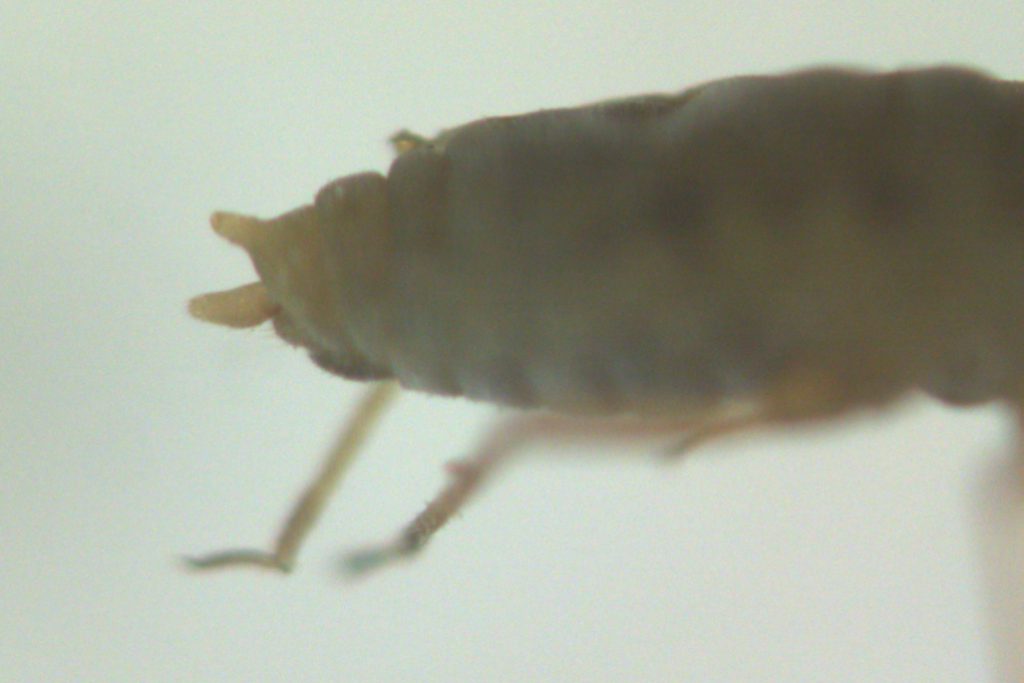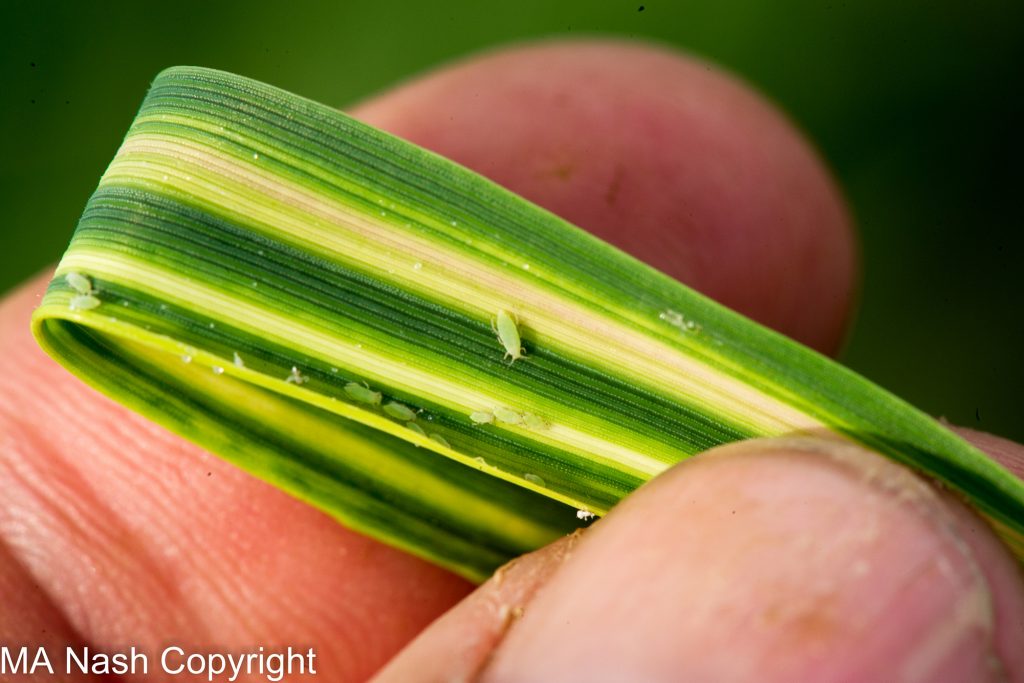Populations of the exotic cereal pest, the Russian wheat aphid, have now been reported beyond the South Australian border in Victoria.
Where have they been reported?
We have received a sample of the Russian wheat aphid (Diuraphis noxia) from across the SA border in the Kaniva area of the Victorian Wimmera. Samples have been forwarded to Agriculture Victoria for an official confirmation of the identification.
The Russian wheat aphid had not previously been reported in Australia, prior to May 13th when it was detected in a wheat paddock near Tarlee in the SA Mid North region. The initial detection resulted in further surveillance in the region by PIRSA Biosecurity SA and SARDI entomologists, which led to the discovery of more infestations.
Contrary to some reports, experts believe Russian wheat aphid is unlikely to have blown on winds directly from South Africa.
Agriculture Victoria is assisting with surveillance and identification, and is currently receiving samples.
Russian wheat aphid will almost certainly spread to other States. Victorian and NSW growers and agronomists are requested to report any suspicious aphids.
About Russian wheat aphid
Description and identification
The Russian wheat aphid is indigenous to southern Russia, the Middle East and Central Asia, and has since spread to all major grain growing countries.
Wingless adults grow up to about 2 mm long and have distinctively short antennae.
They are light green in colour and can appear coated with a whitish wax.
In addition, there are three other conspicuous features which can help distinguish Russian wheat aphid from other cereal aphids.
The first is its elongated body. While the bodies of established cereal aphids are often pear or globe-shaped, Russian wheat aphid is longer and more spindle-shaped.
The second feature is the apparent lack of siphuncles, which are commonly referred to as ‘exhaust pipes’. These structures are notable on most aphids, however they cannot be seen on Russian wheat aphid with the naked eye.
The third diagnostic feature is the presence of two caudae or a ‘double tail’ at the rear end of the aphid. This can be seen best when viewing the aphid from a profile perspective. However, these do not develop until the fourth and fifth instar stage of its lifecycle.
Adult Russian wheat aphid can be winged (alates) which are also up to 2 mm. However unlike wingless Russian wheat aphid, the antennae are body-length, and the body is generally darker in colour.


Lifecycle
In its native range, the annual lifecycle of Russian wheat aphid includes sexual and asexual phases. However, like most other introduced aphid pests in Australia, invasive populations of Russian wheat aphid reproduce asexually with females giving birth to live female offspring.
In autumn, aphids may infest cereal seedlings soon after emergence, often from wingless aphids walking off nearby senescing hosts. Aphids require actively growing plants for development; populations start to increase from tillering and stem elongation.
Aphids regularly move by walking among leaves, tillers and plants, so that the percentage of infested plants increases during the crop cycle. Population growth becomes most rapid from booting onwards.
Winged Russian wheat aphid are weak flyers but probably travel on wind currents efficiently enough for some aphids to locate isolated host plants or new crops. Suction traps have been established in the vicinity of the SA outbreak, but these have recorded very few dispersing Russian wheat aphid.
Like other aphids, populations of Russian wheat aphid are strongly regulated by environmental conditions. Survival of aphids outside the shelter of leaf rolls is affected by exposure to rainfall, drying winds, and beneficial insects. Rainfall washes aphids from upper leaves, and heavy rainfall may cause 50% mortality. Despite having a higher tolerance to colder temperatures than other cereal aphids, the population growth of Russian wheat aphid will be reduced with the onset of cold and wet conditions.
Hosts and plant damage
Wheat, barley and durum wheat are primary hosts to Russian wheat aphid. This means that the pest can feed on these plants at any stage of its lifecycle and reproduction can occur in crop.
Other important agricultural crops such as oats, rye, triticale and rice are secondary hosts. These crops only support Russian wheat aphid as an adult and just prior to reaching maturity, meaning that it cannot complete its lifecycle on these crops.
There are also many grasses, both cultivated and wild species, which can host Russian wheat aphid. Bromus grasses are particularly important to Russian wheat aphid survival and population build-up.
The Russian wheat aphid is distinct from other cereal pests as it injects salivary toxins in addition to removing nutrients during feeding. Even a few aphids can cause plant damage symptoms to appear as early as 7 days after infestation.
These include:
- Curled, rolled or hollow tube leaves
- Discoloured leaves
- White and purple streaks on leaves
- Stunted growth or flattened appearance
- Hooked-shaped head growth from awns trapped in curling flag leaf
- Bleached heads
The salivary toxins injected by Russian wheat aphid during feeding damages plant chloroplasts, resulting in reduced photosynthetic ability, delayed leaf initiation and tillering, reduced numbers of fertile tillers, shoot and root biomass, grains per ear and grain weight.
Under USA conditions, heavy infestations during early growth can cause serious damage.
From early booting to soft dough stage, feeding on upper leaves, in the leaf sheath and next to the developing head, can cause direct yield losses. In wheat and barley, damaged leaf tissue does not recover. If aphids are controlled, new growth proceeds normally (new root and shoots are unaffected) and plants may recover unless excessively stressed. After the soft dough stage, further impact is minimal.

Our advice
It was announced today through the Department of Agriculture and Water Resources (DAWR), that the National Management Group (NMG), comprising all Australian governments, Grain Producers Australia and Plant Health Australia, has agreed that it is not technically feasible to eradicate Russian wheat aphid from Australia.
It is now unlikely that the infestation of Russian wheat aphid is practically containable to the current infestation zone. This implies that the grain growers will need to adapt to this pest and manage it along with the suite of other aphid species. We expect the number of detections in Victoria to increase over the coming months.
The NMG agreed that a national management plan for Russian wheat aphid be developed to manage the pest in Australia.
In any case, population growth and spread of Russian wheat aphid over winter is likely to be minimal. Cold temperatures and rainfall will limit activity. This has already been observed by SARDI entomologists since the recent onset of cold conditions in SA.
In the event of detection, Russian wheat aphid may be controlled with a suitable insecticide if numbers exceed the recommended threshold.
Most of the SA crops where Russian wheat aphid have been detected following the initial infestation at Tarlee had only low populations.
Adopt best-practice farm hygiene procedures to retard the spread of aphids between fields and adjacent properties. Keep traffic out of affected areas and minimise movement in adjacent areas.
We do not recommend prophylactic spraying for aphids using broad-spectrum insecticides, even if aphids have been found locally.
If Russian wheat aphid appear in local crops, they will most likely also be in nearby non-crop grasses.
Broad-spectrum insecticides will destroy beneficial species, leaving the crop vulnerable to reinvasion and greater damage by more locally established Russian wheat aphid and other cereal aphids.
General management strategies
Monitoring/sampling
Aphids may infest crops during any stage of crop development, from early establishment to maturating flag leaf. Check crops regularly following seedling emergence. Russian wheat aphid are often difficult to find when at low numbers. Check for the characteristic leaf streaking and rolling. Infestations often begin along crop edges, usually on the windward side or adjacent to infested grasses. Russian wheat aphid also commonly occurs in areas of paddocks where plants are sparse or adjacent to bare ground. After initial infestation, aphids can rapidly spread across a paddock.
SARDI entomologists have found weather conditions can affect the distribution of aphids on plants. During inclement weather, Russian wheat aphid were only found on lower leaves and in their leaf sheaths on volunteer cereals, but were more broadly distributed over plants during fine weather.
Chemical control
Chemical control of Russian wheat aphid is effective; there is no known insecticide resistance in this pest.
Due to the cryptic feeding habits of Russian wheat aphid, complete coverage and use of an insecticide with fumigant or systemic activity is required. In many regions, organophosphate insecticides are commonly recommended. Seed treatments are likely to offer some early season protection, as indicated by preliminary results collected by SARDI and staff from an Agrilink early season wheat trial in SA infested with Russian wheat aphid.
Decisions on the need for foliar treatments are based on the proportion of seedlings or tillers infested.
Economic Threshold (ET) guidelines recommended in the USA vary somewhat between region.
Based on best available information, SARDI have suggested an ET of 20% seedlings infested up to the start of tillering, and 10% seedlings infested thereafter.
Cultural control
Cultural controls include eliminating refuge volunteer cereals and grasses in fallows and other areas during summer and autumn; later planting of winter cereals to delay and reduce early aphid infestation; agronomic practices to promote crop vigour and dense canopy growth, which inhibit Russian wheat aphid populations and reduces their impact on the crop.
Biological control
Russian wheat aphid are attacked by a range of beneficial insects.
Of these, groups that commonly occur in Australia include the parasitoid wasps Aphidius colemani, Aphidius ervi, Diaeretiella rapae and generalist predators including ladybird beetles, lacewings, damsel bugs, hoverflies, carabid beetles, and also entomopathogenic fungi.
SARDI entomologists have already observed mummified and fungus diseased Russian wheat aphid.
Acknowledgements
This article was adapted from information provided by SARDI entomologists and the Plant Health Australia Fact Sheet.
Sources of field reports of Russian wheat aphid
Simon Mock – Consultant, Clovercrest Consulting (Wimmera Vic)
Further resources
Russian wheat aphid Contingency Plan – Plant Health Australia
Russian wheat aphid fact sheet – Plant Heath Australia
Cover image: Photo by Elia Pirtle, Cesar Australia





